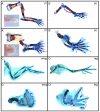Generation of mice with functional inactivation of talpid3, a gene first identified in chicken
- PMID: 21750036
- PMCID: PMC3133916
- DOI: 10.1242/dev.063602
Generation of mice with functional inactivation of talpid3, a gene first identified in chicken
Abstract
Specification of digit number and identity is central to digit pattern in vertebrate limbs. The classical talpid(3) chicken mutant has many unpatterned digits together with defects in other regions, depending on hedgehog (Hh) signalling, and exhibits embryonic lethality. The talpid(3) chicken has a mutation in KIAA0586, which encodes a centrosomal protein required for the formation of primary cilia, which are sites of vertebrate Hh signalling. The highly conserved exons 11 and 12 of KIAA0586 are essential to rescue cilia in talpid(3) chicken mutants. We constitutively deleted these two exons to make a talpid3(-/-) mouse. Mutant mouse embryos lack primary cilia and, like talpid(3) chicken embryos, have face and neural tube defects but also defects in left/right asymmetry. Conditional deletion in mouse limb mesenchyme results in polydactyly and in brachydactyly and a failure of subperisoteal bone formation, defects that are attributable to abnormal sonic hedgehog and Indian hedgehog signalling, respectively. Like talpid(3) chicken limbs, the mutant mouse limbs are syndactylous with uneven digit spacing as reflected in altered Raldh2 expression, which is normally associated with interdigital mesenchyme. Both mouse and chicken mutant limb buds are broad and short. talpid3(-/-) mouse cells migrate more slowly than wild-type mouse cells, a change in cell behaviour that possibly contributes to altered limb bud morphogenesis. This genetic mouse model will facilitate further conditional approaches, epistatic experiments and open up investigation into the function of the novel talpid3 gene using the many resources available for mice.
Figures








References
-
- Abbott U. K., Taylor L. W., Abplanalp H. (1959). A second talpid-like mutation in the fowl. Poult. Sci. 38, 1185
-
- Baker K., Beales P. L. (2009). Making sense of cilia in disease: the human ciliopathies. Am. J. Med. Genet. C Semin. Med. Genet. 151C, 281-295 - PubMed
Publication types
MeSH terms
Substances
Grants and funding
LinkOut - more resources
Full Text Sources
Molecular Biology Databases

